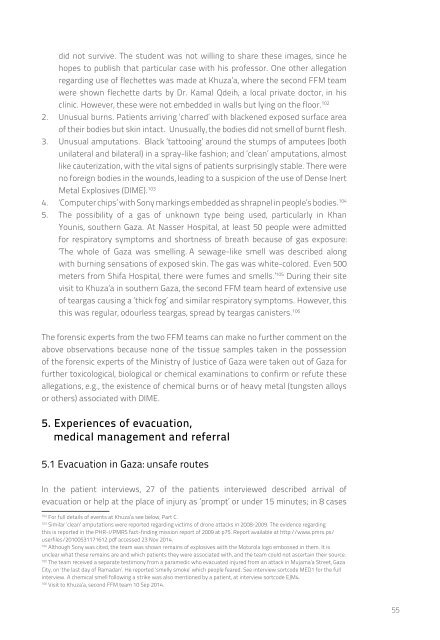HHo0s
HHo0s
HHo0s
You also want an ePaper? Increase the reach of your titles
YUMPU automatically turns print PDFs into web optimized ePapers that Google loves.
did not survive. The student was not willing to share these images, since hehopes to publish that particular case with his professor. One other allegationregarding use of flechettes was made at Khuza’a, where the second FFM teamwere shown flechette darts by Dr. Kamal Qdeih, a local private doctor, in hisclinic. However, these were not embedded in walls but lying on the floor. 1022. Unusual burns. Patients arriving ‘charred’ with blackened exposed surface areaof their bodies but skin intact. Unusually, the bodies did not smell of burnt flesh.3. Unusual amputations. Black ‘tattooing’ around the stumps of amputees (bothunilateral and bilateral) in a spray-like fashion; and ‘clean’ amputations, almostlike cauterization, with the vital signs of patients surprisingly stable. There wereno foreign bodies in the wounds, leading to a suspicion of the use of Dense InertMetal Explosives (DIME). 1034. ‘Computer chips’ with Sony markings embedded as shrapnel in people’s bodies. 1045. The possibility of a gas of unknown type being used, particularly in KhanYounis, southern Gaza. At Nasser Hospital, at least 50 people were admittedfor respiratory symptoms and shortness of breath because of gas exposure:‘The whole of Gaza was smelling. A sewage-like smell was described alongwith burning sensations of exposed skin. The gas was white-colored. Even 500meters from Shifa Hospital, there were fumes and smells.’ 105 During their sitevisit to Khuza’a in southern Gaza, the second FFM team heard of extensive useof teargas causing a ‘thick fog’ and similar respiratory symptoms. However, thisthis was regular, odourless teargas, spread by teargas canisters. 106The forensic experts from the two FFM teams can make no further comment on theabove observations because none of the tissue samples taken in the possessionof the forensic experts of the Ministry of Justice of Gaza were taken out of Gaza forfurther toxicological, biological or chemical examinations to confirm or refute theseallegations, e.g., the existence of chemical burns or of heavy metal (tungsten alloysor others) associated with DIME.5. Experiences of evacuation,medical management and referral5.1 Evacuation in Gaza: unsafe routesIn the patient interviews, 27 of the patients interviewed described arrival ofevacuation or help at the place of injury as ‘prompt’ or under 15 minutes; in 8 cases102For full details of events at Khuza’a see below, Part C.103Similar ‘clean’ amputations were reported regarding victims of drone attacks in 2008-2009. The evidence regardingthis is reported in the PHR-I/PMRS fact-finding mission report of 2009 at p75. Report available at http://www.pmrs.ps/userfiles/20100531171612.pdf accessed 23 Nov 2014.104Although Sony was cited, the team was shown remains of explosives with the Motorola logo embossed in them. It isunclear what these remains are and which patients they were associated with, and the team could not ascertain their source.105The team received a separate testimony from a paramedic who evacuated injured from an attack in Mujama’a Street, GazaCity, on ‘the last day of Ramadan’. He reported ‘smelly smoke’ which people feared. See interview sortcode MED1 for the fullinterview. A chemical smell following a strike was also mentioned by a patient, at interview sortcode EJM4.106Visit to Khuza’a, second FFM team 10 Sep 2014.55


